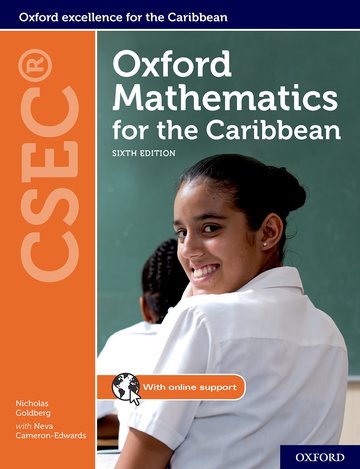Oxford Mathematics for the Caribbean CSEC
A clear, discovery oriented series that brings mathematics to life
Author Nicholas Goldberg and Author Neva Cameron-Edwards
Suitable for: CSEC Mathematics, 14-16
Price: £25.99
ISBN:
978-0-19-841401-8
Publication date:
06/07/2017
Paperback:
544 pages
Dimensions:
246x189mm
Availability: In stock.
You can use the basket to:
- pay by credit card
- order on account
- forward to a colleague
Description
Features
- Covers everything - this edition has been revised and updated to fully match the latest CSEC syllabus, for first examination in 2018
- Builds mathematical confidence with extensive practice exercises - throughout the textbook, by way of online support and the newly extended workbook
- SBA support is also included, with worked examples and suggestions for project work
This page was last updated on 22 December 2024 at 20:30 GMT
Table of Contents
Curriculum matching grid
Introduction
1 Computation and number
1.1: Operations with whole numbers
1.2: Some number theory
1.3: Negative numbers
1.4: Calculating with fractions
1.5: Calculating with decimals
1.6: Fractions and decimals
1.7: Rounding off numbers
1.8: Indices
1.9: Standard form
1.10: Arithmetical rules and laws
1.11: Number bases
1.12: Ratio and proportion
Consolidation
Summary
2 Measurement
2.1: Length
2.2: Area
2.3: Areas of triangles and quadrilaterals
2.4: Circles
2.5: Arcs and sectors
2.6: Surface area
2.7: Volume
2.8: Measurement and scales
2.9: Error in measurements
Consolidation
Summary
3 Consumer arithmetic
3.1: Money management
3.2: Profit and loss
3.3: Interest and investment
3.4: Hire purchase and mortgages
3.5: Rates and taxes
Consolidation
Summary
4 Algebra 1
4.1: Basic algebra
4.2: Binary operations
4.3: Linear equations
4.4: Linear inequalities
4.5: Simultaneous equations
4.6: Word problems
Consolidation
Summary
5 Investigations and problem solving
5.1: Patterns and sequences
5.2: Investigations
Consolidation
Summary
6 Sets
6.1: Union, intersection and complement
6.2: Drawing and using Venn diagrams
6.3: Finding the number of subsets
6.4: Numbers and sets
6.5: Solving problems
Consolidation
Summary
7 Geometry
7.1: Angles
7.2: Symmetry
7.3: Classifying shapes
7.4: Polygons
7.5: Constructions
7.6: Solids
7.7: Circle theorems
Consolidation
Summary
8 Functions 1
8.1: Mapping diagrams
8.2: Function notation
8.3: Functions, relations and graphs
8.4: Working with functions – conversions
Consolidation
Summary
9 Graphs 1
9.1: Reading and plotting graphs
9.2: Linear relations
9.3: Equations of lines
Consolidation
Summary
10 Trigonometry 1
10.1: Right-angled triangles and Pythagoras' theorem
10.2: Sines, cosines and tangents
10.3: Angles of elevation and depression
10.4: Bearings
10.5: The sine and cosine rules
10.6: Areas of triangles and parallelograms
10.7: Sectors and segments
Consolidation
Summary
11 Statistics
11.1: Collecting data
11.2: Organising data
11.3: Displaying data
11.4: Averages – measures of central tendency
11.5: Measures of dispersion
Consolidation
Summary
12 Probability
12.1: The idea of probability
12.2: Experimental probability
12.3: Theoretical probability
Consolidation
Summary
13 Transformations 1
13.1: Translations
13.2: Rotations
13.3: Reflections
13.4: Enlargements
13.5: Similar triangles
13.6: Congruency
Consolidation
Summary
14 Functions 2
14.1: The inverse of a function
14.2: The composition of mappings and functions
14.3: Composition and inverses
Consolidation
Summary
15 Algebra 2
15.1: Indices
15.2: Changing the subject of a formula
15.3: The product of two brackets
15.4: Factorising quadratic expressions
15.5: Solving quadratic equations
15.6: Equations in two variables
15.7: Word problems
15.8: Variation
Consolidation
Summary
16 Graphs 2
16.1: Quadratic graphs
16.2: Maximum and minimum values for quadratic functions
16.3: Gradients of curves
16.4: Plotting other graphs
16.5: Distance–time and speed–time graphs
Consolidation
Summary
17 Vectors and matrices 1
17.1: Vectors
17.2: Using vectors in geometry
17.3: Position vectors
17.4: Matrices
17.5: Multiplying matrices
Consolidation
Summary
18 Transformations 2
18.1: More on reflections
18.2: More on rotations
18.3: Combining transformations
Consolidation
Summary
19 Graphs 3
19.1: Solving simultaneous equations graphically
19.2: Solving quadratic equations graphically
19.3: Graphs of inequalities
19.4: Linear programming
Consolidation
Summary
20 Vectors and matrices 2
20.1: The inverse of a matrix
20.2: Simultaneous equations
20.3: Transformation matrices
20.4: Combining transformations
Consolidation
Summary
© 2024 Oxford University Press. All rights reserved.






